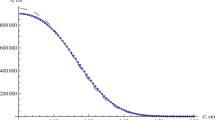Abstract
The results from a particle-in-cell code developed to describe the drifting of ions in an ionized buffer gas are described. The rate of ionization was found to have a dramatic effect on the collection efficiency of the heavy ions and results of the calculations agree well with recent observations.
Similar content being viewed by others
References
Äystö, J.: Development and applications of the IGISOL technique. Nucl. Phys. A 693, 477–494 (2001)
Savard, G. et al.: Development and operation of gas catchers to thermalize fusion-evaporation and fragmentation products. Nucl. Instrum. Methods Phys. Res. B 204, 582–586 (2003)
Weissman, L. et al.: Conversion of 92 MeV/u 38Ca/37K projectile fragments into thermalized ion beams ((and the references therein)). Nucl. Instrum. Methods Phys. Res. A 540, 245–258 (and the references therein) (2005)
Wada, M. et al.: Space-charge effects in the catcher gas cell of a rf ion guide. Rev. Sci. Instrum. 76, 103503 (2005)
Neumayr, J.B. et al.: The ion-catcher device for SHIPTRAP. Nucl. Instrum. Methods Phys. Res. B 244, 489–500 (2006)
Bollen, G. et al.: Experiments with thermalized rare isotope beams from projectile fragmentation: a precision mass measurement of the superallowed β emitter 38Ca. Phys. Rev. Lett. 96, 152501-1-4 (2006)
Morrissey, D.J. et al.: Comissioning the A1900 projectile fragment separator. Nucl. Instrum. Methods Phys. Res. B 204, 90–96 (2003)
Huyse, M. et al.: Intensity limitations of a gas cell for stopping, storing and guiding radioactive ions. Nucl. Instrum. Methods Phys. Res. B 187, 535–547 (2002)
Morrissey, D.J.: Extraction of thermalized projectile fragments from gas. Eur. Phys. J. A (in press)
Palestini, S. et al.: Space charge in ionization detectors and the NA48 electromagnetic calorimeter. Nucl. Instrum. Methods Phys. Res. A 421, 75–89 (1999)
Nasser, E.: Fundamentals of gaseous ionization and plasma electronics. In: Brown, S.C. (ed.). Wiley, New York (1971)
Sauli, F.: Principles of operation of multiwire proportional and drift chers. In: Ferbel, T. (ed.) Experimental Techniques in High-Energy Nuclear and Particle Physics. World Scientific, Singapore (1991)
Mitchell, D.W., Smith, R.D.: Two dimensional many particle simulation of trapped ions. Int. J. Mass Spectrom. Ion Process. 165/166, 271–297 (1997)
Velissaris, C.: A time-dependent solution for the operation of ion chambers in a high-ionization background. Nucl. Instrum. Methods Phys. Res. A 547, 511–516 (2005)
Author information
Authors and Affiliations
Corresponding author
Rights and permissions
About this article
Cite this article
Facina, M., Bollen, G. & Morrissey, D.J. Space charge effects on stopped projectile fragment drift in gas. Hyperfine Interact 174, 21–26 (2007). https://doi.org/10.1007/s10751-007-9559-7
Published:
Issue Date:
DOI: https://doi.org/10.1007/s10751-007-9559-7




